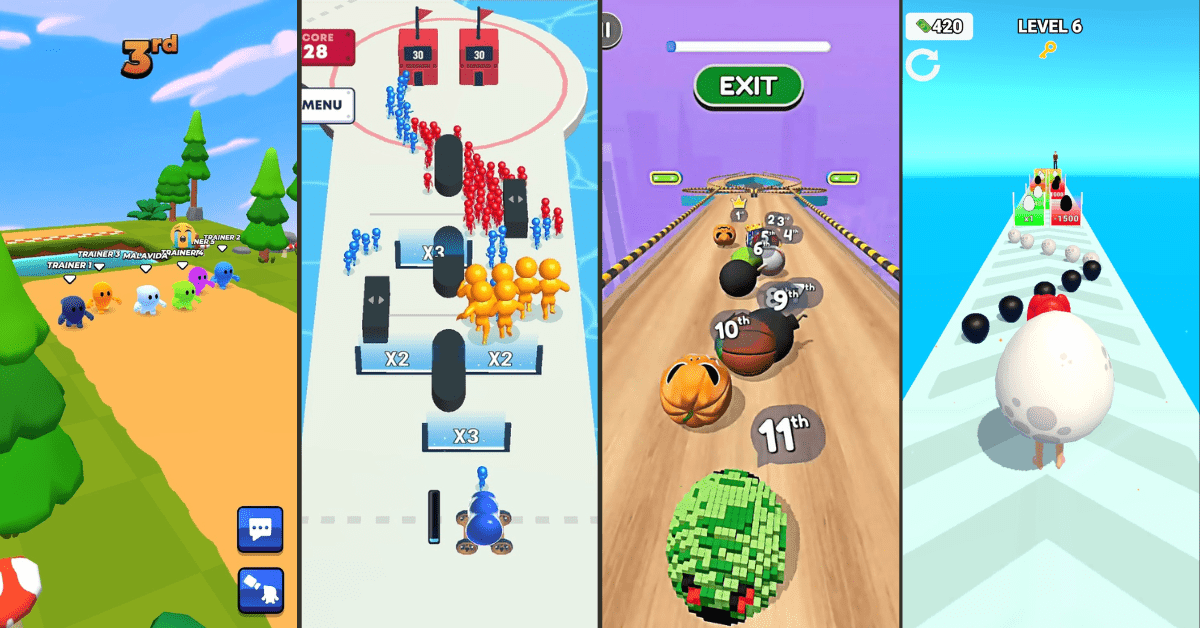Hyper casual games are transforming mobile gaming with their simple yet addictive appeal. This article will explore their unique mechanics, impact on the market, and the secrets behind their profitability.
Get ready to discover what sets hyper casual games apart in the fast-paced mobile gaming industry.
What Are Hyper Casual Games: Definition
Hyper casual games are mobile games that focus on simple, intuitive gameplay, typically involving basic tapping or swiping actions. These games feature straightforward 2D graphics and user interfaces, allowing for instant play without complex instructions or tutorials.
This genre is characterized by its endless gameplay.
Players enjoy a continuous experience without definitive endpoints, often aiming to achieve high scores or use the game as a leisurely pastime.
Such simplicity in design and function resonates with a wide audience of players, making hyper casual games a popular choice for players looking for quick, engaging gaming sessions.
How Big Is the Hyper-Casual Game Market?
The hyper-casual game market has shown significant growth and transformation in recent years.
Hyper Casual Games Revenue
In 2023, the hyper-casual market was valued at around USD 16.67 billion, as reported by Statista. Looking forward, it’s projected to reach about USD 25.96 billion by 2030, growing at a Compound Annual Growth Rate (CAGR) of 7.67%.
This growth trend underscores the rising popularity and financial potential of the hyper-casual gaming sector.
Hyper Casual Games Downloads
According to Pocket Gamer, there were 3.5 billion downloads of hyper casual games in the third quarter of 2023. This figure was an 8% decrease from the previous quarter, suggesting a declining trend in the popularity of hyper casual games. This decrease points to a saturated market, where many older games continue to hold significant influence.
Yet, there is a positive aspect for the hyper-casual game market. New games developed with innovative concepts are expected to make a notable impact.

Hyper Casual Subgenres
It’s clear that some sub-genres within the hyper-casual market are exhibiting different trends.
For example, idler games have shown consistent growth in both downloads and in-game purchases. Conversely, genres like simulators, .io games, satisfaction games, and racing are seeing a decline.
This changing landscape of the hyper-casual game market, with its shifting trends and the potential of new, creative titles, keeps the genre both challenging and engaging for developers and players.
Are Hyper Casual Games Profitable?
Despite a recent drop in downloads, hyper casual games continue to be a profitable sector in the mobile gaming industry, as this doesn’t directly translate to a decline in profitability.
The key lies in understanding the current dynamics of the hyper casual game market.
The decline in downloads indicates a market that is increasingly saturated, with older, established games still dominant.
However, this also opens the door for innovation.
New games that are developed with unique ideas and engaging mechanics have the potential to stand out and attract players’ attention.

What Is the Most Profitable Hyper-Casual Game?
AppMagic, a leading mobile intelligence platform, reports that the most profitable hyper casual game in the past year was Pocket Champs 3D Racing Games by Madbox, generating over $20 million in revenue. This was closely followed by Mob Control by Voodoo, which earned more than $18 million in revenue.
Who Plays Hyper Casual Games?
Hyper casual games, known for their broad appeal, have attracted a diverse range of players worldwide.
These games are especially accessible thanks to their straightforward “tap-to-play” mechanics, making it easy for people from various backgrounds and gaming experiences to engage effortlessly.

Why Do People Play Hyper Casual Games?
According to Facebook’s hyper-casual games report, the main 7 reasons why people play hyper-casual games are:
- To alleviate stress
- To pass time
- The feeling of accomplishment after completing a challenge
- To dive into another world or character
- They are impressed by something unique
- To nurture something unique about them
- As a connection to something they are passionate about in real life
Game developers should have these motivations in mind when developing and advertising a hyper-casual game.
Hyper Casual Gamers’ Preferences on Ads and In-App Purchases
Hyper-casual gamers tend to prefer longer, less frequent ads to shorter, more frequent ones.
This trend is consistent across different regions, with 85% of players in South Korea, 82% in the UK, and 79% in the US being open to in-app ads. This openness to advertising highlights a distinctive aspect of the hyper-casual gaming audience’s behavior.
In contrast, in-app purchases are not as common among hyper-casual gamers as they are in other gaming genres. The likelihood of making in-app purchases within a month is relatively low, with only 3.7% in the US, 3% in the UK, and 1.9% in South Korea engaging in such transactions.

Common Hyper Casual Game Mechanics
- Rise/Fall: Involves controlling an object to either rise or fall, often with obstacles and varying speeds to increase difficulty.
- Tap/Timing: Requires players to tap the screen at precise times to perform actions like jumping or avoiding obstacles.
- Dexterity: Players keep their fingers on the screen to move objects, involving both precision and timing.
- Merging: Players find and merge similar objects to form improved items, often under time pressure or for higher scores.
- Stacking: Involves stacking objects with a focus on balance and timing. The difficulty can increase with speed and smaller landing areas.
- Turning: Typically involves navigating a moving object (like a vehicle) through a course with turns, requiring timely swipes or taps.
- Growing: Players grow an object by absorbing others, such as in classic snake games, with the challenge increasing as the object grows larger and faster.
- Swerving: Similar to turning, but involves continuous finger movement on the screen to navigate through tracks or obstacles.
- Idle Mechanics: Games that progress with minimal input from players, often involving management or upgrade systems that operate autonomously.
- Resizing: Players adjust the size of an object to fit through gaps or overcome obstacles, focusing on spatial awareness and timing.
- Pushing: Centers around pushing objects or players out of an area, with physics-based gameplay and often a last-man-standing objective.
- Puzzle Mechanics: Involves solving puzzles by placing or arranging objects, emphasizing logical thinking and strategy.

How Do You Make a Successful Hyper-Casual Game?
Creating a successful hyper-casual game relies on several key principles.
1. Focus on Simplicity
At the heart of hyper-casual games is simplicity. Your game should be straightforward to understand and play. A user should grasp the concept within seconds of gameplay. This ease in design and mechanics is essential for attracting a wide audience.
2. Ensure Quick and Engaging Gameplay
Hyper-casual game players seek quick entertainment. Your game should provide instant engagement. Craft short, enjoyable play sessions that offer immediate satisfaction and are challenging enough to keep players returning.
3. Optimize for Short Attention Spans
Your gameplay should be designed to immediately capture players’ attention. Incorporate elements that make the first few seconds of the game both captivating and engaging.
4. Iterate Based on Feedback
Consistently collect and analyze player feedback. Utilize this information to refine and enhance your game. Player feedback is invaluable for understanding what is effective and what isn’t.
5. Monetization Strategy
Although in-app purchases are less frequent in hyper-casual games, advertising revenue is a major income source. Develop a monetization strategy that resonates with player preferences, like choosing longer but less frequent ads.
6. Regular Updates and Fresh Content
Keep your game dynamic and interesting with regular updates. Adding new levels, challenges, or features can keep players engaged and maintain interest in your game.

How Much Does It Cost to Make a Hyper Casual Game?
Developing a hyper-casual game involves costs associated with game development, art production, technology, and marketing.
The costs for hyper-casual games vary based on several factors:
Development Costs
For a basic hyper-casual game development costs can range from around $20,000 to $25,000. This estimate is for games with fundamental functionalities. The exact cost depends on the complexity of the core gameplay loop and the extent of art production required.
If you aim for a game with more advanced features, a hybrid casual game, the development cost may reach up to $80,000 and more.
Just to give you an idea, according to Sacra, a research company, Voodoo spends up to $20,000 on a soft launch. For a confirmed release, on the other hand, they pay $180,000.
Marketing Costs
Marketing is a critical component for the success of hyper-casual games and a significant portion of the budget often goes towards user acquisition, primarily through advertising.
Cost Per Install (CPI) for Hyper Casual Games
Developers should focus on achieving a low CPI while maintaining high retention rates.
Let’s break it down.
Here are common CPIs for hyper casual games in the US market.
From our experience, you can expect to pay from $0.20 to $1.00 per install on Android. More specifically, around $0.20 for an excellent hyper casual game (example – Helix Jump – $0.18 CPI), from $0.30 to $0.50 for a good game, and from $0.50 to $1.00 for an okay game.
For iOS, add 20% to 30% on top of that.
So, to acquire 100,000 users for a hyper casual game, you can expect to pay an average of $50,000 on Android and around $60,000 on iOS, depending on how good your game is. If you have a hit game, the costs can be as low as $20,000.
Hyper Casual Games Monetization Strategy
Hyper-casual games are not only unique in terms of game mechanics, but also in the way they’re monetized.
Here’s how to make money from hyper-casual games.
In-App Ads
Hyper casual games primarily generate revenue through in-app ads, utilizing a mix of rewarded video, playable and interstitial ads. While this approach may not yield high income per user, it compensates with volume due to the massive scale of hyper casual game downloads.
Here’s how it works:
Scale and Reach
Hyper casual games are designed to appeal to a broad audience. The wider the game’s reach, the greater the number of players who will view and interact with ads. This scale is crucial, as the revenue generated per user is typically low.
Seamless Integration
Ads are integrated into the game in a way that feels natural and unobtrusive. The goal is to ensure that ads don’t disrupt the gameplay experience. Ads are often placed at logical stopping points, like in between levels or during game load times.

In-App Purchases
While an ad-based monetization method has been proven to work exceptionally well for hyper-casual games, it’s worth exploring other options like in-app purchases. Currently, it’s popular to use a hybrid monetization model, which combines in-app ads with in-app purchases.
It can be beneficial to hyper-casual games because relying on just one revenue stream is rarely a good idea. By adding an additional revenue stream in the form of in-app purchases, developers can diversify their monetization model.
Furthermore, certain ad formats like rewarded video ads work well in tandem with in-app purchases. According to ironSource, rewarded video ads can boost in-app purchases 6x! In fact, 4 in 5 developers believe that rewarded video ads work even better in a hybrid model than on their own (Walnut Unlimited). This is another good reason to include in-app purchases in your monetization model and maximize your ROI.

What Is the Future of Hyper Casual Games?
Here’s how the hyper-casual market is evolving and what you can do keep up the pace.
1. From Hyper-Casual to Hybrid-Casual
There has been a noticeable shift from purely hyper-casual games to a hybrid-casual format.
In 2023, there was a tenfold increase in the release of hybrid-casual games compared to previous years. This shift shows a growing trend towards combining elements of both hyper-casual and more complex game genres.
Build a Queen is a good example of that – read all about it in our dissection.
2. Complexity and Customization in Game Design
Hybrid-casual games are narrowing the gap between the simplicity of hyper-casual games and the intricate elements of mid-core games.
By adding increased complexity and customization options, these games attract audiences who desire more than the basic gameplay of traditional hyper-casual titles. This approach extends their appeal, attracting players with a wider range of gaming preferences.
3. Cross-Promotion and Enhanced Monetization Strategies
A rising strategy in this changing market is the cross-promotion between hyper-casual and hybrid-casual games.
This approach helps developers effectively address industry challenges. It provides a dynamic way to boost player retention and expand monetization opportunities. Leveraging the strengths of both game types, developers can establish a more diverse and sustainable revenue model.
4. Focusing on Retention and Engagement
Retention and engagement are key to the success of hybrid-casual games. These games balance accessibility with progression, featuring elements like meta-game features, new levels, varied game modes, and season passes. These features aim to foster loyalty and motivation among players, offering depth without requiring a significant time investment.
5. Evolution in Monetization Strategies
The monetization models in hyper-casual games are changing.
Shifting from a reliance solely on in-app advertising, there is a movement towards a hybrid model that integrates advertising with in-app purchases. This shift is creating a new niche within the hyper-casual genre, offering a more diverse and potentially more profitable approach to game monetization.








Comments